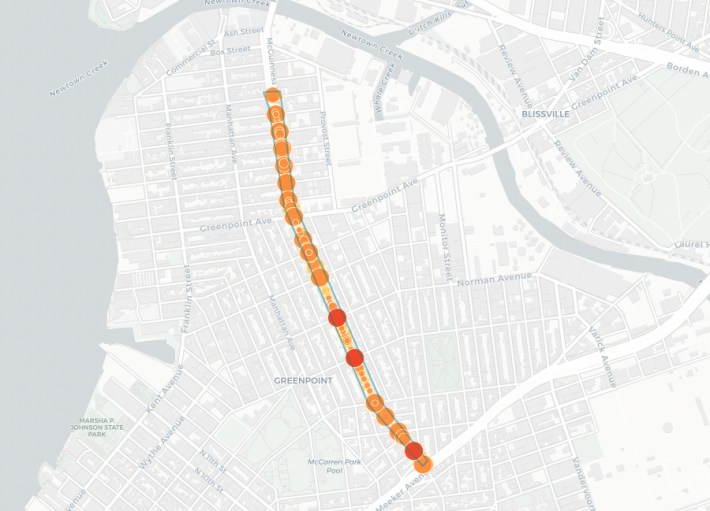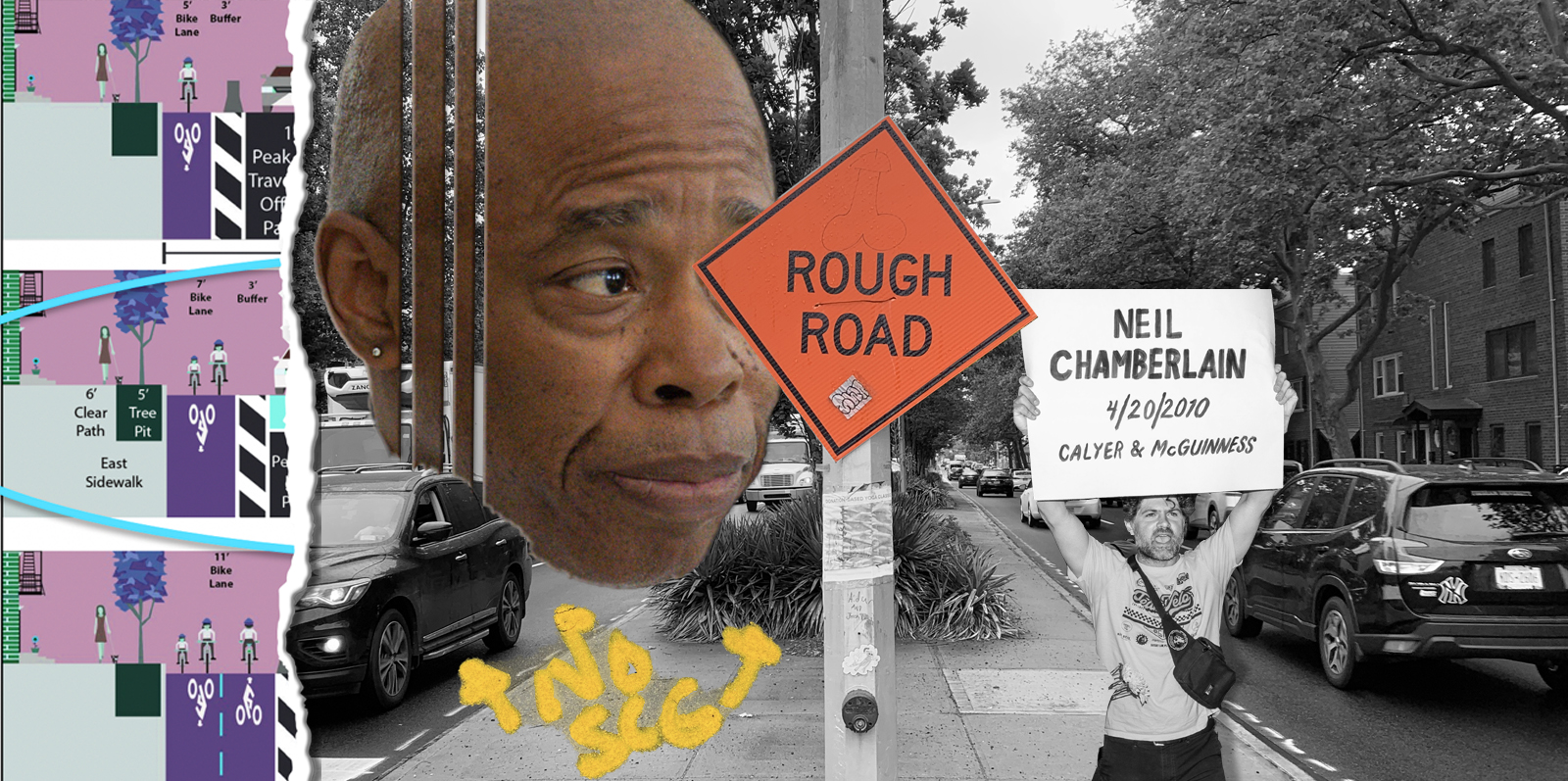Mayor Adams's decision to weaken — for a second time — a popular plan for a safety redesign of one of Brooklyn's most-dangerous streets on behalf of powerful business interests once again casts into dramatic relief the mayor's failure to put safety first or, his harshest critics say, even on the agenda in the first place.
Last week, Hizzoner's move to reject the Department of Transportation's plan to reduce McGuinness Boulevard by one lane in each direction — a move he made after pressure from big business in the neighborhood who hated the revamp, chiefly the film studio and Adams's political donors Broadway Stages.
That decision only inflamed the elected officials who supported the road diet.
"Mayor Adams says he cares about safety, except when it comes to McGuinness Boulevard," said Council Member Lincoln Restler.
So how did this happen? How did a Vision Zero city move from a $40-million safety redesign announced by then-Mayor Bill de Blasio after a beloved teacher was killed by a reckless driver in 2021 to a plan that does not appreciably slow down drivers? Here's a timeline of debacle:
Decades of danger
McGuinness Boulevard used to be a quiet residential road called Oakland Street until the 1950s, when planners condemned properties to expand it following the opening of the Pulaski Bridge. Officials gave it its current name in 1963, and the highway-like artery has brought pollution, death, injuries and a wide divider to the northern Brooklyn neighborhood ever since.

The roughly mile-long stretch between the Brooklyn-Queens Expressway and the Pulaski has logged nearly 2,000 reported crashes since 2011, injuring more than 500 people — about one every 10 days — and killing three, according to city data.
Advocates began calling on the city to make the street safer in 2009, after a flatbed truck driver killed a local DJ Solange Raulston, 33, and after another hit-and-run driver mowed down 28-year-old Neil Chamberlain months later, with activists calling the road a "racetrack."
A 2012 study by Transportation Alternatives showed that two-thirds of drivers speed on McGuinness, and after Nicole Detweiler was killed in a wreck in 2014, local pols again demanded DOT do something about the deadly conditions.
The promise
In May 2021, a hit-and-run driver fatally struck local teacher Matthew Jensen, prompting then-Mayor Bill de Blasio to pledge $39 million to fix the boulevard. DOT would start with an in-house redesign the next year before a larger capital project.
DOT, now overseen by Mayor Adams, presented three options in July 2022 — all of which would include a bike lane protected in some form or another:
- turning the outer lane into parking overnight
- converting the outside lane into parking full-time thereby and reducing McGuinness from four lanes to two
- installing a two-way bike lane on the southbound side of the road while leaving the north-bound section intact.
The city chose the middle option — reducing the road's travel lanes and installing a parking protected bike lane — Streetsblog exclusively revealed almost a year later. That option was also the one that had the full support of the neighborhood's elected officials.

That plan also had the most support among locals, according to DOT, and the agency has ranked road diets as the most effective street safety redesign, reducing death and serious by 30 percent for all road users.
The road diet would have been a boon to pedestrians thanks to shorter crossings, while also promising maintain vehicle storage and setting up loading zones for drivers and deliveries servicing the businesses on McGuinness.
The pushback
Critics, led by the theatrical production company Broadway Stages, were angered by the plans and whipped up opposition under the moniker "Keep McGuinness Moving," a group that included several trucking companies that had killed people in crashes.
The Broadway Stages owners, Gina and Tony Argento, had a history of stymying street safety in north Brooklyn, with Tony coming out against a bike lane on the Greenpoint Avenue Bridge back in 2009. Gina, who sits on Community Board 1, railed against a proposed bike lane on Monitor Street in 2022, where Broadway Stages would later apply to privatize that road for a backlot.
The redesign opponents worried that fewer travel lanes would snarl traffic and hurt businesses — despite DOT data showing that 30 to 50 percent of the traffic on the road is simply short-cut drivers. To appease the critics, the agency even prepared maps with Broadway Stages' locations that showed that the company's trucks did not even rely on McGuinness to get around.
All local pols supported the road diet, and lawmakers slammed the opponents for stoking fear in the neighborhood.
Broadway Stages flexed their political muscle by hosting a bizarre town hall-style meeting inside a one of its soundstages in mid-June 2023, reeling in DOT leadership, plus the head of the Brooklyn Democratic Party (an Assembly member whose district is miles away from the area in question). Meanwhile, supporters of the redesign were locked out of the "town hall."
Betrayal
In July 2023, the mayor first caved to the opponents, who got the ear of his closest adviser Ingrid Lewis-Martin, and ordered DOT to go back to the drawing board.
Lewis-Martin reportedly told the mayor that businesses hated the plans and that its supporters from outside the community. Residents rallied in support of the plan the following days proving her wrong.
The mayor's right hand is a frequent saboteur of street safety projects, and has since set up a rogue chain of command at City Hall to interfere in DOT's efforts, including bus lanes on Fordham Road in the Bronx, and bike lanes on Brooklyn's Ashland Place and Underhill Avenue.
In the days that followed the mayor's backpedal, Adams went on to mock Restler at a press conference, while DOT Commissioner Ydanis Rodriguez tried to stay "positive" that the plan wasn't dead in the water.
But in August, DOT revealed that the city would walk back the redesign on the section north of Calyer Street, by leaving the outer lane intact for drivers during the daytime, and converting it into parking overnight, a half-measure that became known as the Calyer Compromise.
The carnage continued on the roadway, and the mayor officially signed off on the compromise later that month, and DOT began work in September.
It was unclear what would happen with the southern section, as DOT said in a late Friday news dump in September that it would need to do more "analysis" that could "inform any adjustments" on the stretch between Calyer and the BQE.
Backpedal upon backpedal
The fate of McGuinness remained in limbo in 2023 as DOT installed the half-measure on the northern stretch.
Politicians slammed the compromise design as doing "nothing" for pedestrians, who now had to cross four car lanes and two bike lanes, while cyclists were forced to swerve around illegally-parked cars in the bike lane and into fast-moving traffic.
Meanwhile, Broadway Stages applied to demap Monitor Street in the spring in order to secure its own private back lot on a stretch where DOT had planned to install a bike lane in 2022. Broadway Stages opposed that bike lane, too, and it went nowhere. In 2023, a 73-year-old cyclist died in a crash on that street.
The McGuinness redesign loomed over the Democratic primaries this past June, as politicians who backed the overhauls faced challengers supported by Broadway Stages, but the pro-road diet candidates all cruised to victory.
Then on Tuesday, the Adams administration put the death knell in any hopes for a road diet on McGuinness, with DOT announcing it would scale back the redesign along the entire roadway. The overnight parking lanes that have not worked on the north will continue all the way down to the BQE, with construction starting in September.
"The mayor [is] pushing ahead with a plan that does nothing to address the central safety concerns of our community," Assembly Member Emily Gallagher said. "But we'll keep fighting until McGuinness is safe."
Public Advocate Jumaane Williams slammed the mayor for "playing politics."
"Street safety is about saving lives, not playing politics," he said on Twitter. "For the sake of New Yorkers who lost loved ones to traffic violence on McGuinness, we must finally Make McGuiness Safe, listening to the community, local businesses, and DOT's evidence-based plan, not the select few."






